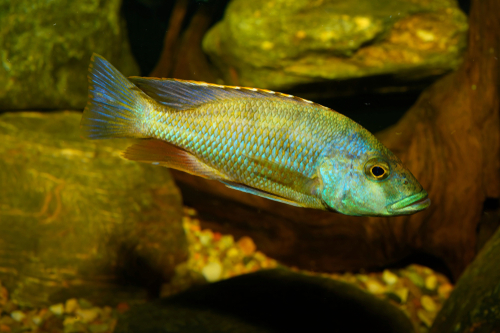African cichlids are a popular fish species found in freshwater habitats in Africa. They are known for their vibrant colors and unique patterns, making them a favorite among aquarium enthusiasts.
One of the most important aspects of keeping African cichlids healthy and happy is their diet. In this article, we will explore what African cichlids eat and how to provide them with a balanced diet.
Understanding the dietary needs of African cichlids is crucial for their survival in an aquarium. These fish are omnivores, meaning they eat both plant and animal-based foods.
In the wild, they feed on a variety of organisms including insects, crustaceans, and algae. In captivity, it’s important to replicate their natural diet to ensure they receive all the necessary nutrients.
In the next section, we will discuss the different types of food that African cichlids can eat and how to incorporate them into their diet.
Contents
Key Takeaways on What Do African Cichlids Eat?
- African cichlids are omnivores and require a balanced diet of both plant and animal-based foods.
- Their natural diet consists of insects, crustaceans, and algae.
- A balanced diet for African cichlids can include pellets, flakes, frozen foods, and fresh vegetables.
You will also like these other related posts:
Understanding African Cichlids
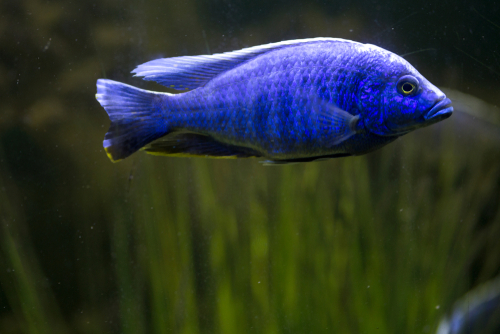
African cichlids are a popular species of freshwater fish that are native to Africa’s rift lakes, including Lake Malawi, Lake Victoria, and Lake Tanganyika.
They are highly diverse and come in a wide range of colors, patterns, and sizes. African cichlids are known for their aggressive behavior, territorial nature, and their ability to adapt to different environments.
There are over 2,000 species of cichlids, with more than 1,000 being found in Africa. They are classified into two main groups: riverine and rift lake cichlids.
Riverine cichlids are found in rivers and streams, while rift lake cichlids are found in the African rift lakes.
African cichlids are known for their vibrant colors and unique patterns. The males are typically more colorful than the females, and they use their colors to attract mates and establish dominance over other males.
The patterns on their bodies can also be used to identify different species of African cichlids.
African cichlids are omnivores, which means that they eat both plant and animal matter. Their diet can vary depending on their species and their natural habitat.
Some species of African cichlids are herbivores and feed on algae, while others are carnivores and feed on small fish and invertebrates.
Habitats of African Cichlids
African cichlids are found in a variety of habitats, including lakes, rivers, and streams. They are native to the African continent, with the majority of species found in Lake Malawi, Lake Tanganyika, and Lake Victoria.
These lakes are known for their high levels of biodiversity, with hundreds of different species of cichlids found in each lake.
Lake Malawi is home to over 1,000 species of cichlids, making it one of the most diverse freshwater ecosystems in the world. The cichlids in this lake are known for their bright colors and unique patterns.

They are found in rocky habitats, where they feed on algae and small invertebrates.
Lake Tanganyika is the second deepest lake in the world and is home to over 200 species of cichlids. The cichlids in this lake are known for their elongated bodies and large eyes, which allow them to see in the dimly lit depths of the lake.
They are found in rocky and sandy habitats, where they feed on algae, small invertebrates, and fish.
Lake Victoria is the largest lake in Africa and is home to over 500 species of cichlids. The cichlids in this lake are known for their bright colors and unique patterns. They are found in shallow, weedy habitats, where they feed on algae and small invertebrates.
In addition to these lakes, African cichlids are also found in rivers and streams throughout the continent. They are known for their adaptability and can survive in a wide range of water conditions.
Some species of cichlids are also found in South America, where they have been introduced as aquarium fish.
Dietary Needs of African Cichlids
African cichlids are a diverse group of fish that have different dietary needs depending on their species and size. Some cichlids are herbivores, some are carnivores, and some are omnivores. It is important to provide a varied diet to ensure they get all the necessary nutrients.
Types of Food
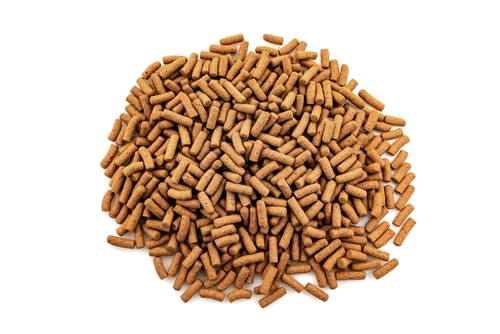
Cichlids can eat a variety of foods, including pellets, flakes, frozen foods, and live or frozen brine shrimp. Herbivorous cichlids will enjoy eating vegetables such as peas, cucumber, zucchini, and lettuce. They may also eat algae and plants.
Carnivorous cichlids will prefer foods high in protein such as small fish, insects, larvae, and shrimp pellets. Omnivorous cichlids will eat a mix of both plant and animal-based foods.
Cichlid Pellets
Cichlid pellets are a popular choice for feeding African cichlids. They come in sinking and floating varieties and are designed to provide a balanced diet for cichlids.
However, it is important to choose high-quality pellets that are specifically made for cichlids.
Foods to Avoid
Some foods should be avoided when feeding African cichlids. Spinach and broccoli, for example, contain oxalates which can bind to calcium and prevent it from being absorbed.
Tropical flakes may not provide enough protein for carnivorous cichlids, and some frozen foods may contain preservatives that can harm cichlids.
Feeding Frequency
African cichlids should be fed small amounts of food several times a day rather than one large meal.
Overfeeding can lead to health problems such as obesity, bloating, and poor water quality. It is also important to remove any uneaten food from the tank to prevent it from decomposing and polluting the water.
African Cichlids in an Aquarium
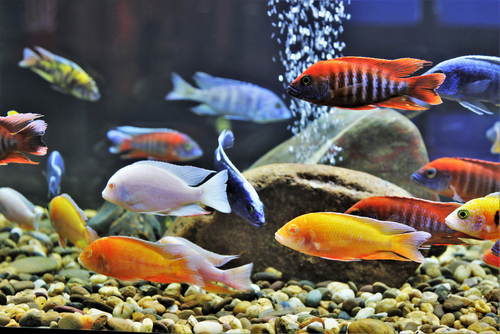
African cichlids are a popular choice for freshwater aquariums due to their vibrant colors and active behavior. However, it’s important to understand their dietary needs to ensure they thrive in a captive environment.
When it comes to feeding, African cichlids are omnivorous, meaning they eat both plant and animal matter. In the wild, they feed on algae, small crustaceans, and insects.
In an aquarium, they can be fed a variety of foods, including pellets, flakes, frozen or live foods, and even vegetables.
It’s important to note that African cichlids can be aggressive towards each other and other fish in the aquarium. Therefore, it’s recommended to feed them multiple times a day to reduce competition for food.
Additionally, providing a variety of food options can help reduce aggression as they won’t be fighting over the same type of food.
When setting up an aquarium for African cichlids, it’s important to provide plenty of hiding spots and caves made from rocks or other materials.
This will give them a place to retreat to when they feel threatened or stressed. Sand is also a popular substrate choice as it mimics their natural environment and allows them to sift through it for food.
Maintaining proper water quality is crucial for the health of African cichlids. They prefer a pH between 7.8 and 8.6 and a temperature between 75 and 82 degrees Fahrenheit.
A powerful filter is also necessary to keep the water clean and prevent bloat, a common health issue in African cichlids.
In terms of tank size, African cichlids require a minimum of 55 gallons for a small group. As they grow and reproduce, a larger tank may be necessary to accommodate their needs.
Health and Lifespan of African Cichlids
African Cichlids are hardy fish that can live for several years if kept in optimal conditions. The average lifespan of African Cichlids is around 5-8 years, but some species can live up to 15 years if properly cared for.
One of the most common health issues that African Cichlids face is Malawi bloat. This is a condition where the fish’s intestines become blocked and swollen, leading to a loss of appetite and eventually death.
Malawi bloat is often caused by overfeeding or feeding the wrong types of food. To prevent this, it is important to feed African Cichlids a balanced diet that includes both plant and animal-based foods.
In addition to a proper diet, maintaining good water quality is essential for the health and longevity of African Cichlids.
These fish are sensitive to changes in water chemistry and require a pH between 7.8-8.6 and a water temperature between 75-82°F. Regular water changes and the use of a high-quality filtration system can help maintain optimal water conditions.
Behavioral Traits of African Cichlids

African Cichlids are known for their unique and diverse behavioral traits. These fish are highly active and territorial, and their behavior can vary depending on their species and environment.
Here are some common behavioral traits of African Cichlids:
1. Territorial
African Cichlids are known for being territorial fish. They tend to establish territories within their aquarium and defend them fiercely. This territorial behavior can lead to aggression towards other fish, especially if they are of the same species or have similar coloration.
It is important to provide enough space and hiding places in the aquarium to reduce aggression and territorial behavior.
2. Aggression
African Cichlids can be aggressive towards other fish, especially during breeding and feeding times. They have a tendency to nip at fins and chase other fish around the aquarium.
However, not all African Cichlids are aggressive, and some species are more peaceful than others. It is important to research the specific species of African Cichlid before adding them to an aquarium.
3. Active
African Cichlids are highly active fish and require plenty of swimming space in their aquarium. They are constantly on the move, exploring their environment and searching for food.
Providing a variety of hiding places, caves, and rocks can help to create a stimulating environment for these active fish.
4. Temperaments
African Cichlids have a wide range of temperaments, from peaceful to highly aggressive. Their temperament can depend on their species, environment, and social hierarchy within the aquarium.
It is important to observe the behavior of African Cichlids and adjust their environment accordingly to reduce aggression and stress.
5. Semi-aggressive
Many African Cichlids are considered semi-aggressive fish. They have a tendency to chase and nip at other fish, but they are not as aggressive as some other species of fish.
Semi-aggressive African Cichlids can be kept with other semi-aggressive fish, but it is important to monitor their behavior and adjust their environment if necessary.
Breeding African Cichlids

Breeding African cichlids can be a rewarding experience for hobbyists. However, it requires careful consideration of several factors. For example, the breeding process can be affected by factors such as water quality, temperature, and diet.
Mbuna cichlids are known for their aggressive behavior, which can make breeding them a challenge. Therefore, it is recommended to keep a ratio of one male to several females to reduce aggression.
Aulonocara and peacock cichlids, on the other hand, are less aggressive and can be bred in pairs.
To increase the chances of breeding success, it is important to provide the cichlids with a suitable environment. This includes providing hiding places such as caves or rocks for the fish to lay their eggs.
Additionally, maintaining good water quality and temperature can help stimulate breeding behavior.
When it comes to diet, it is important to provide the cichlids with a varied diet that includes high-quality protein sources such as shrimp, krill, and worms.
Feeding them a diet rich in vitamins and minerals can also help improve their overall health and increase their chances of successful breeding.
Types of African Cichlids
African cichlids are a diverse group of fish that come in many different shapes, sizes, and colors. They are found in a variety of habitats throughout Africa, including lakes, rivers, and streams. Some of the most popular types of African cichlids include:
Genera
There are several different genera of African cichlids, each with its own unique characteristics. Some of the most common genera include:
- Aulonocara: Known for their bright colors and peaceful nature, Aulonocara cichlids are popular among aquarium enthusiasts.
- Haplochromis: With over 200 species, Haplochromis cichlids are one of the most diverse groups of African cichlids.
- Neolamprologus: These cichlids are known for their interesting behaviors and complex social structures.
- Pseudotropheus: Often referred to as “Mbunas,” Pseudotropheus cichlids are known for their aggressive behavior and bright colors.
Mbunas
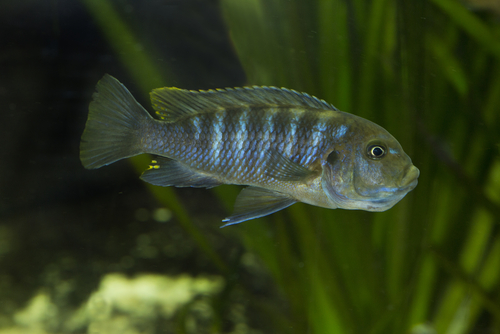
Mbunas are a group of cichlids that are found in Lake Malawi. They are known for their aggressive behavior and territorial nature, making them a popular choice for experienced aquarium hobbyists.
Some of the most popular Mbuna species include:
- Labidochromis caeruleus: Also known as the “Electric Yellow,” this species is known for its bright yellow coloration.
- Metriaclima estherae: This species, also known as the “Red Zebra,” is known for its striking red and blue coloration.
- Pseudotropheus demasoni: With its black and blue stripes, this species is one of the most distinctive Mbuna cichlids.
Diverse
There are many other types of African cichlids that don’t fit neatly into any one category. Some of these include:
- Astatotilapia burtoni: This species is known for its unique breeding behavior, which involves the male building a “sandcastle” to attract females.
- Julidochromis transcriptus: These cichlids are known for their elongated bodies and interesting social behavior.
- Lamprologus ocellatus: Also known as the “Shell-Dweller,” this species is known for its unique habit of living inside empty snail shells.
Feeding African Cichlids
African Cichlids are omnivorous, meaning they eat both animal and plant-based foods. It is important to provide them with a balanced diet to ensure their health and longevity.
In the wild, African Cichlids feed on a variety of foods including insects, insect larvae, and invertebrates. In captivity, they can be fed a combination of flakes, pellets, and frozen or live foods.
When selecting commercial foods, it is important to choose a high-quality brand that contains the necessary nutrients for African Cichlids. Look for foods that contain iron and chromium, which are essential for their health.
In addition to commercial foods, African Cichlids can also be fed vegetables such as spinach, zucchini, and peas. These foods provide important vitamins and minerals that are not found in commercial foods.
It is important to avoid overfeeding African Cichlids as they are prone to obesity. Feed them small amounts several times a day rather than one large meal.
Care Tips for African Cichlids
Given their diverse needs and behaviors, African Cichlids require careful attention to keep them healthy and happy. Here are some pro tips:
- Water Quality: Always maintain high water quality. Cichlids are sensitive to changes and poor water conditions can lead to stress and disease.
- Filtration: A high-quality filtration system is crucial. A combination of mechanical, chemical, and biological filtration is usually recommended.
- Environment: Make sure to provide plenty of rocks, caves, and other hiding spots, especially if you have territorial species.
- Compatibility: Always research which species you can keep together to minimize aggression. Sometimes, mixing fish with different color patterns can reduce territorial disputes.
- Monitoring: Keep an eye on your fish. If you see any signs of stress, disease, or aggression, take appropriate measures immediately.
- Professional Help: When in doubt, consult with a veterinarian experienced in treating exotic fish.
Feeding Frequency: How Often Should You Feed Your Cichlids?
The frequency at which you should feed your cichlids varies depending on factors such as age, species, and overall health. In the wild, cichlids are opportunistic feeders, eating whenever they come across suitable food.
In a home aquarium, though, it’s common practice to feed them once or twice a day. If you’re asking “do African cichlids eat other fish?” because you’re worried about overfeeding, note that overfed cichlids may indeed become more aggressive. Mayan cichlids and other varieties also display similar behavior when overfed.

Younger fish might require more frequent feedings, while adults can adhere to a more regular schedule. If you’re contemplating adding treats like bloodworms into their diet and wonder “can African cichlids eat bloodworms?”, it’s advisable to offer these treats sparingly, perhaps once a week, to avoid over-nutrition.
Frequently Asked Questions

What is the best food for African cichlids?
African cichlids are omnivores that require a balanced diet of both meaty and plant-based foods. A high-quality pellet or flake food specifically formulated for cichlids is a good staple diet.
These foods should contain a mix of protein, vitamins, and minerals. Additionally, supplementing their diet with fresh or frozen foods like brine shrimp, krill, and spinach can provide variety and additional nutrients.
How many pellets should I feed my cichlids?
It’s recommended to feed your African cichlids small amounts of food several times a day rather than one large feeding. A good rule of thumb is to feed them an amount they can consume within 2-3 minutes. Overfeeding can lead to health problems and water quality issues.
What else can I feed my African cichlids?
In addition to pellets and flakes, African cichlids can be fed a variety of fresh or frozen foods like bloodworms, daphnia, and brine shrimp. Vegetables like spinach, zucchini, and peas can also be offered.
Just be sure to avoid feeding them anything that is toxic to fish, like avocado or citrus fruits.
What do peacock cichlids eat?
Peacock cichlids are a type of African cichlid that primarily feed on small crustaceans and insects in the wild. In captivity, they can be fed a diet of high-quality pellets, supplemented with fresh or frozen foods like krill, brine shrimp, and bloodworms.
What do small African cichlids eat?
Small African cichlids have smaller mouths and require smaller food particles. They can be fed a diet of small pellets or flakes, supplemented with foods like daphnia, brine shrimp, and finely chopped vegetables.
Can African cichlids eat bloodworms?
Yes, African cichlids can eat bloodworms as part of their diet. Bloodworms are a good source of protein and can be fed as a supplement to their staple diet of pellets or flakes. Just be sure to feed them in moderation, as too many can lead to digestive issues.

Ian Sterling, founder of Fishlab.com, began his aquarium journey over 30 years ago, driven by a deep fascination for fish and their diverse personalities. His website, Fishlab.com, is dedicated to making fishkeeping accessible and enjoyable, offering beginner-friendly guidance, expert insights, and a community for aquarists to connect and share experiences.


